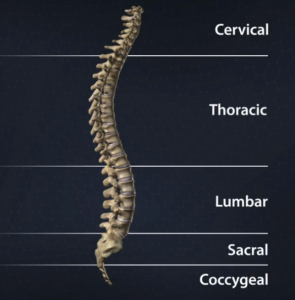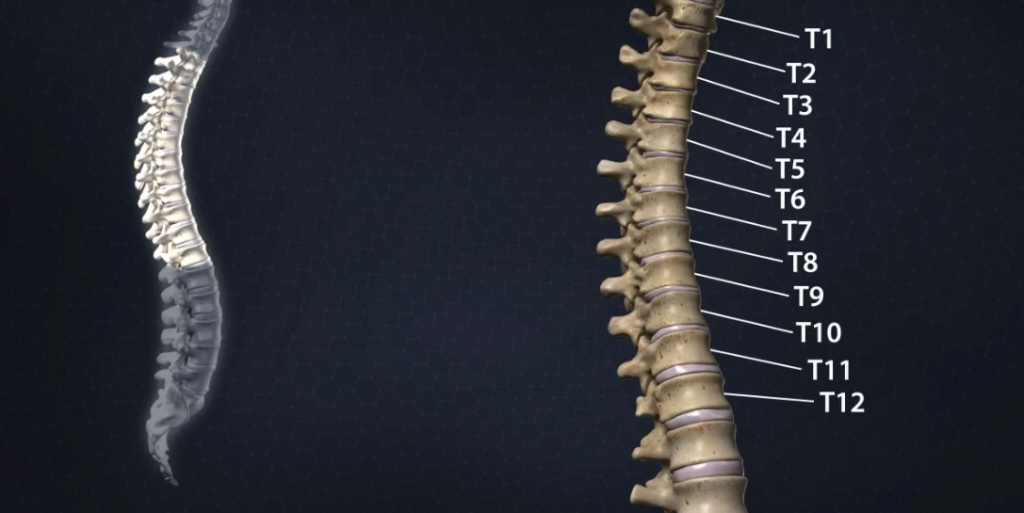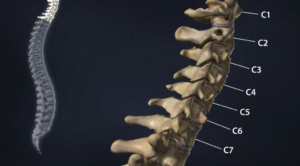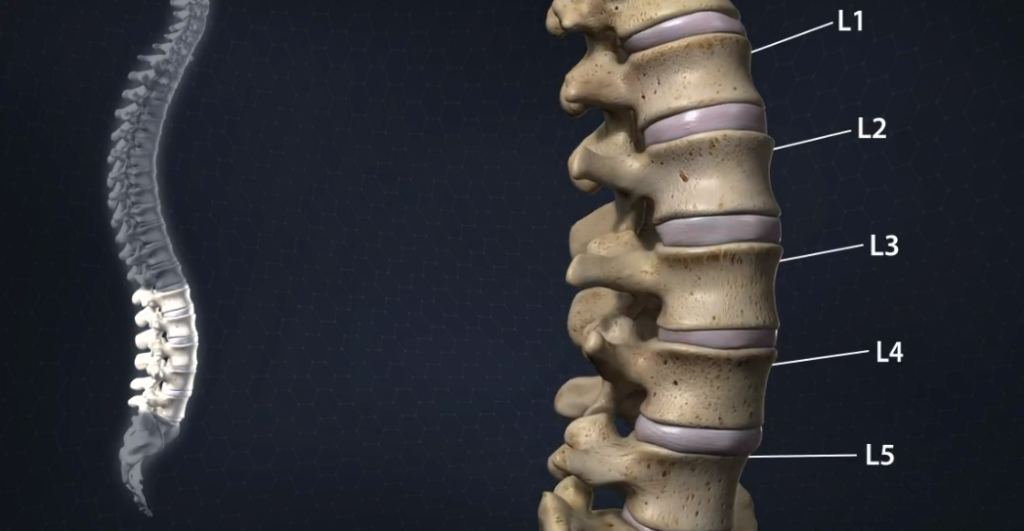Contact us today to know more about the anatomy of the spine or request an appointment online!
Anatomy Of The Spine
What is the spine?
 Your spine, or backbone, is your body’s central support structure. It connects different parts of your musculoskeletal system. Your spine helps you sit, stand, walk, twist and bend. Back injuries, spinal cord conditions, and other problems can damage the spine and cause back pain.
Your spine, or backbone, is your body’s central support structure. It connects different parts of your musculoskeletal system. Your spine helps you sit, stand, walk, twist and bend. Back injuries, spinal cord conditions, and other problems can damage the spine and cause back pain.
The human spine is a complex anatomical structure that provides scaffolding for the entire body. It offers some important features, including:
- Protects the spinal cord and nerves
- It structurally supports the body and allows it to stand upright. The spine supports about half of the body’s weight.
Each person is born with an average of 33 individual bones (vertebral bones) that interact and connect through flexible joints called facets. By the time a person becomes an adult, most vertebrae have only 24 because some of the vertebrae at the lower end of the spine fuse together during normal growth and development. Occasionally, a person may have extra vertebrae called transitions, usually located at the sixth lumbar level (labeled L6).
The bottom of the spine is called the sacrum. It usually consists of multiple vertebral bodies that are integrated into one body. The remaining small bones or ossicles below the sacrum also join together and are called coccyx or coccyx. The spine above the sacrum includes the following:
- Seven neck bones – cervical spine
- Twelve bones in the chest – the thoracic spine
- Five pelvic bones – lumbar spine
The spine combines strong bones, unique joints, flexible ligaments and tendons, large muscles and highly sensitive nerves. Many of us take the benefits of a healthy spine for granted, but back pain is a stark reminder of how dependent we are on our backs in our daily lives. Some of the causes of spine pain are:
- Irritation when large nerves leave the bony area of the spine and connect to the arms and legs
- Stimulation of smaller nerves in the spine by innervating or supplying intervertebral discs between vertebrae, facet joints and ligaments.
- Stretching the large back muscles that keep the spine straight
- Bone, ligament or joint damage
- Disc damage or disease that separates vertebrae
- Abnormal movement between sections
- Tumors, infections, trauma, deformities or other disorders of the spine
 The spine is made up of many parts, all of which are designed to help with flexible movement, bear weight, and protect the spinal cord and nerves. These parts include the:
The spine is made up of many parts, all of which are designed to help with flexible movement, bear weight, and protect the spinal cord and nerves. These parts include the:
- Vertebrae: The spine has 33 vertebrae (small bones) that form the spinal canal. The spinal canal is a tunnel that houses the spinal cord and nerves and protects them from injury. Most vertebrae move to create a range of motion. The lower vertebrae (sacrum and coccyx) are fused together and do not move. (anatomy of the spine)
- Facet joints: These joints of the spine have cartilage (sliding connective tissue) that allows the vertebrae to slide over each other. Fast joints allow you to twist and turn for flexibility and stability. These joints suffer from arthritis, which can cause back and neck pain.
- Intervertebral discs: These smooth and round cushions are located between the vertebrae and act as shock absorbers for the spine. Each disc has a soft gel-like center (nucleus) surrounded by a flexible outer ring (annulus). The intervertebral disc is under constant pressure. A herniated disc may rupture and leak some of the gel material in the nucleus. A herniated disc (also known as a herniated disc, herniated disc, or herniated disc) can be painful.
- Spinal cord and nerves: The spinal cord is a column of nerves that travels through the spinal canal. The umbilical cord extends from the skull to the waist. 31 pairs of nerves branch out from the opening (neural foramen) of the vertebra. These nerves carry messages between the brain and muscles.
- Soft tissue: Ligaments connect the vertebrae and hold the spine in place. Muscles support your back and help you move. Tendons connect muscles to bones and help them move.
What are the spine segments?
The 33 vertebrae make up five distinct spine segments. Starting at the neck and going down toward your buttocks (rear end), these segments include:
- Cervical (neck): The top part of the spine has seven vertebrae (C1 to C7). These neck vertebrae allow you to turn, tilt and nod your head. The cervical spine makes an inward C-shape called a lordotic curve.
- Thoracic (middle back): The chest or thoracic part of the spine has 12 vertebrae (T1 to T12). Your ribs attach to the thoracic spine. This section of the spine bends out slightly to make a backward C-shape called the kyphotic curve.
- Lumbar (lower back): Five vertebrae (L1 to L5) make up the lower part of the spine. Your lumbar spine supports the upper parts of the spine. It connects to the pelvis and bears most of your body’s weight, as well as the stress of lifting and carrying items. Many back problems occur in the lumbar spine. The lumbar spine bends inward to create a C-shaped lordotic curve.
- Sacrum: This triangle-shaped bone connects to the hips. The five sacral vertebrae (S1 to S5) fuse as a baby develops in the womb, which means they don’t move. The sacrum and hip bones form a ring called the pelvic girdle.
- Coccyx (tailbone): Four fused vertebrae make up this small piece of bone found at the bottom of the spine. Pelvic floor muscles and ligaments attach to the coccyx.

What conditions and disorders affect the spine?
Up to 80% of Americans experience back pain at some point. Vertebrae and intervertebral discs wear out with age and can cause pain. Other conditions that affect the health of the spine include:
- Arthritic conditions such as ankylosing spondylitis (AS).
- Back stretching and sprains.
- Birth defects such as spina bifida.
- Osteophytes (serrated edges of the vertebrae that put pressure on the spinal cord and nerves).
- Curvature of the spine (scoliosis and kyphosis).
- Neuromuscular diseases such as amyotrophic lateral sclerosis (ALS).
- Nerve damage such as spinal stenosis, sciatica and nerve compression.
- Osteoporosis (weak bones).
- Spinal injuries such as spinal fracture, disc herniation and paralysis.
- Spinal tumors and cancer.
- Spinal infections such as meningitis and osteomyelitis.

When should I call the doctor?
You should call your healthcare provider if you experience:
- Back pain with fever.
- Bowel or bladder control issues.
- Leg weakness or pain that moves from your back down your legs.
- Pain that worsens, causes nausea or sleeplessness or interferes with daily activities.
If you are suffering from any kind of shoulder pain please contact Spine and Joint Pain Consultants in Interventional Pain Specialist in Houston.
Address :
Midtown Location
4101, Greenbriar Dr, Suite 208
Houston, Texas 77098
Missouri City Location
3634 Glen Lakes Lane, Suite # 101,
Missouri City , Texas 77459
West Location
10190 Katy Fwy Suite 240
Houston – 77043
Phone: 832-777-7246
Fax: 832-706-0777
Timing :
Mon-Fri: 8:30AM to 5:00 PM
Saturday-Sunday Closed
